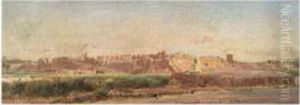Edouard-Henri Girardet Paintings
Édouard-Henri Girardet was a Swiss painter and engraver born on March 30, 1819, in Neuchâtel, Switzerland. He hailed from a prolific family of artists and was one of the sons of Charles Samuel Girardet, who was also an esteemed painter. Édouard-Henri received his initial artistic training from his father and later went on to study in Paris, which was the art capital of the world during the 19th century.
In Paris, Édouard-Henri Girardet was heavily influenced by the Romantic movement and the Orientalist trend that was prevalent among European artists at the time. He was particularly known for his detailed and evocative scenes of Middle Eastern life, capturing the customs, costumes, and landscapes of the region with a captivating realism that was unusual for his time.
Girardet's works were widely exhibited and appreciated during his lifetime. He gained considerable fame and was recognized for his technical skill and his ability to evoke the atmosphere of the places he depicted. His engravings and paintings were often featured in salons and exhibitions throughout Europe.
Despite his success, Édouard-Henri Girardet remained deeply attached to his Swiss roots. Throughout his career, he maintained a connection with his homeland, and his works often reflected a sense of Swiss national pride. He was also known for his historical paintings, which were based on significant events in Swiss history.
Édouard-Henri Girardet passed away on August 25, 1880, in Versailles, France. His legacy is preserved in the form of his numerous paintings and engravings, many of which are held in museums and private collections around the world. His contribution to Orientalist art remains significant, and his works continue to be studied and admired for their historical value and artistic merit.
































